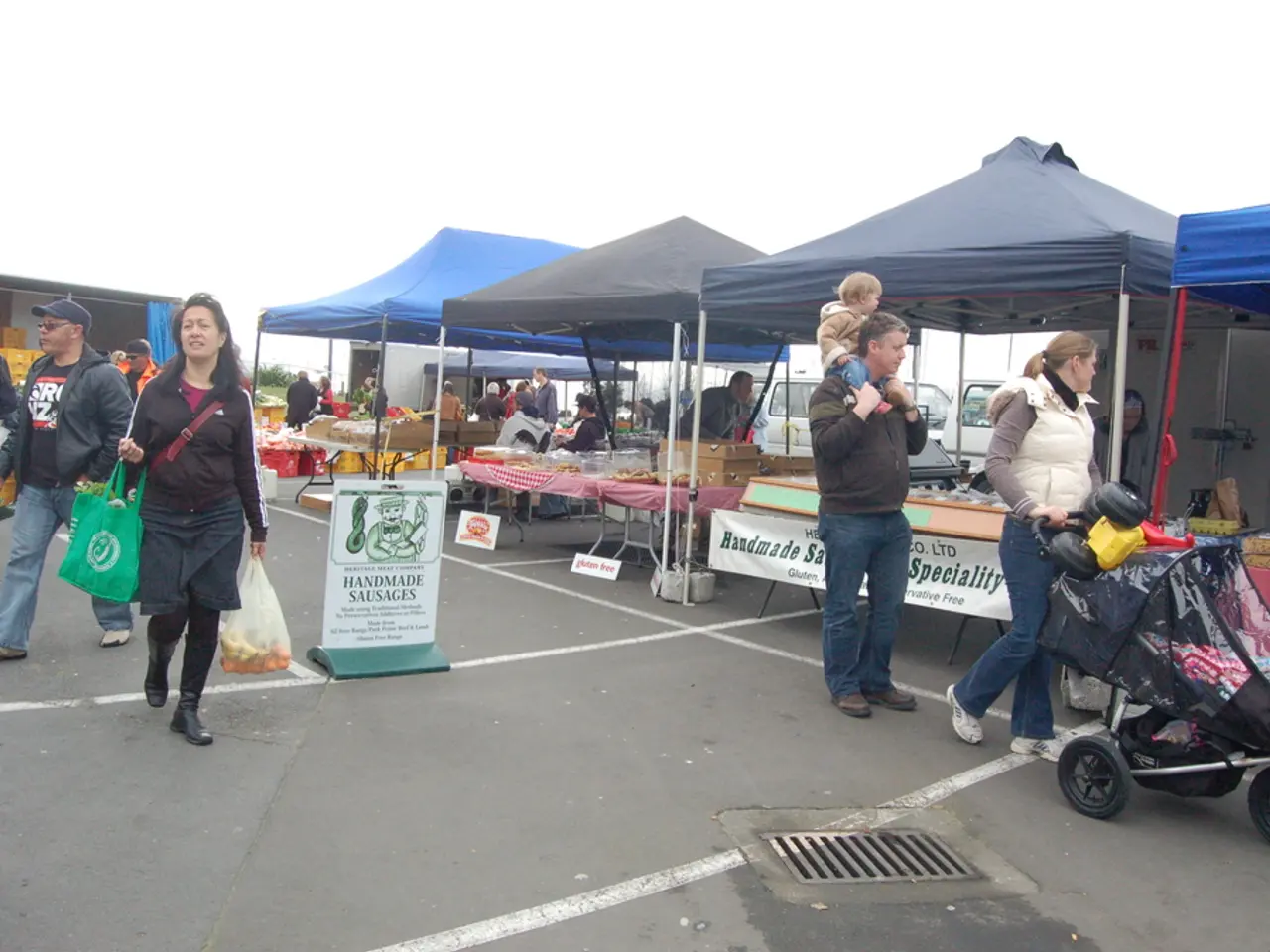Babies on the Move: Nourishment During Journeys
Traveling with a baby can be an exciting yet challenging experience. To ensure smooth feeding experiences for your little one, here are some practical tips to help you manage baby feeding during travel effectively.
Breastfeeding
For breastfeeding mothers, it's essential to carry a nursing cover for privacy if desired. TSA allows you to bring breast milk in reasonable quantities beyond the usual liquid limits. During flights, breastfeeding during takeoff and landing can help your baby equalize ear pressure. If you pump, you can store pumped milk using coolers or specialized shipping services if away for extended periods [1][4][5].
Bottle-Feeding and Formula
For bottle-feeding and formula-fed babies, bring prepared formula or powder and sterilized water (allowed on flights in reasonable amounts). Use a small insulated cooler to keep milk bottles chilled during car trips or travel. On planes, warm bottles using hot water brought onboard or warmed at the gate, as microwaves are not available in-flight. Remember to double diaper your baby before boarding for easier changes [1][3][5].
Solid Foods
For babies on solid foods, pack easy-to-feed options such as jars, pouches, or homemade purees in your diaper bag or a separate food bag. Feeding your baby familiar foods slowly and responsively helps them adjust without stress. Allow your baby to eat at their own pace even while on the go [1][2].
Additional Strategies
- Keep feeding supplies in your carry-on or diaper bag, which usually does not count toward your personal item limit on flights [1].
- Bring hand sanitizer and disinfecting wipes to maintain hygiene in travel environments [3].
- Dress your baby in layered clothing for temperature comfort during travel [3].
- Check with your pediatrician before traveling, especially for flying with an infant or if your baby has health concerns [3].
Preparing for Travel
When traveling, pack essential feeding supplies such as bottles, pacifiers, and utensils. Be prepared for potential changes in the baby's appetite due to motion sickness by adjusting the feeding schedule to coincide with periods of rest during the journey and offering smaller, more frequent meals. Following the baby's typical feeding schedule as closely as possible helps maintain a sense of security and minimizes the impact of the new environment [6].
Consult a pediatrician or carry necessary medications if needed to address travel-induced discomfort such as constipation or diarrhea. Opt for a foldable, portable highchair or booster seat for dining in restaurants with a baby. Scout out baby-friendly spaces for feeding breaks, whether it's a cozy corner in a café or a dedicated nursing room at an airport [7].
Stock up on baby food, formula, and snacks prior to the trip to ensure your baby's nutrition needs are met during travel. Pack easy-to-eat and mess-free foods for babies who have started solids, such as soft fruits, pureed veggies, or yogurt in travel-friendly pouches. It is essential to research the destination's regulations on carrying baby food and milk before embarking on a trip [8].
Plan breaks during travel for feeding and rest to provide opportunities for feeding and rest and to allow the baby to stretch, play, and rest [9]. Consider carrying a portable highchair or booster seat for feeding in restaurants while traveling. For convenience, consider using pre-sterilized disposable bottles [10].
Traveling with a baby requires careful planning and preparation, particularly for their feeding needs. Creating a familiar feeding environment by bringing favorite toys or blankets helps ease any anxiety your baby might feel in a new setting and makes feeding sessions more enjoyable [11]. Invest in a small cooler or insulated bag to keep homemade purees, cut fruits, and snacks fresh during the journey [12].
Use a bottle warmer or thermos for heating water for formula preparation when traveling. Babies have specific nutritional requirements, and maintaining their feeding routine during travel is crucial [13]. Preparing homemade meals, if possible, guarantees freshness and quality for a baby's food during travel [14]. Keep a variety of easily digestible snacks on hand to address changes in appetite due to motion sickness [15]. Carry enough formula powder or pre-made formula for the duration of the trip [16].
By following these practical steps, you can combine preparation, hygiene, and responsive feeding to ensure smooth feeding experiences for your baby on the move. Happy travels!
[1] Mayo Clinic. (2020). Traveling with a baby: Tips for a smooth trip. Retrieved from https://www.mayoclinic.org/healthy-lifestyle/infant-and-toddler-health/in-depth/traveling-with-a-baby/art-20046294
[2] Healthline. (2021). How to feed your baby during travel. Retrieved from https://www.healthline.com/health/parenting/feeding-baby-during-travel
[3] BabyCenter. (2021). Traveling with a baby: Tips for a smooth trip. Retrieved from https://www.babycenter.com/0_traveling-with-a-baby-tips-for-a-smooth-trip_15528866.bc
[4] TSA. (2021). Breast milk and formula. Retrieved from https://www.tsa.gov/travel/security-screening/whatcanibring/items/breast-milk-and-formula
[5] FDA. (2021). Traveling with baby food and milk. Retrieved from https://www.fda.gov/food/baby-food-juice-fruit-puree/traveling-baby-food-and-milk
[6] Verywell Family. (2021). How to Feed Your Baby During Travel. Retrieved from https://www.verywellfamily.com/how-to-feed-your-baby-during-travel-4179687
[7] BabyCenter. (2021). Traveling with a baby: Tips for a smooth trip. Retrieved from https://www.babycenter.com/0_traveling-with-a-baby-tips-for-a-smooth-trip_15528866.bc
[8] Mayo Clinic. (2020). Traveling with a baby: Tips for a smooth trip. Retrieved from https://www.mayoclinic.org/healthy-lifestyle/infant-and-toddler-health/in-depth/traveling-with-a-baby/art-20046294
[9] Healthline. (2021). How to feed your baby during travel. Retrieved from https://www.healthline.com/health/parenting/feeding-baby-during-travel
[10] Verywell Family. (2021). How to Feed Your Baby During Travel. Retrieved from https://www.verywellfamily.com/how-to-feed-your-baby-during-travel-4179687
[11] BabyCenter. (2021). Traveling with a baby: Tips for a smooth trip. Retrieved from https://www.babycenter.com/0_traveling-with-a-baby-tips-for-a-smooth-trip_15528866.bc
[12] Mayo Clinic. (2020). Traveling with a baby: Tips for a smooth trip. Retrieved from https://www.mayoclinic.org/healthy-lifestyle/infant-and-toddler-health/in-depth/traveling-with-a-baby/art-20046294
[13] Healthline. (2021). How to feed your baby during travel. Retrieved from https://www.healthline.com/health/parenting/feeding-baby-during-travel
[14] Verywell Family. (2021). How to Feed Your Baby During Travel. Retrieved from https://www.verywellfamily.com/how-to-feed-your-baby-during-travel-4179687
[15] BabyCenter. (2021). Traveling with a baby: Tips for a smooth trip. Retrieved from https://www.babycenter.com/0_traveling-with-a-baby-tips-for-a-smooth-trip_15528866.bc
[16] Mayo Clinic. (2020). Traveling with a baby: Tips for a smooth trip. Retrieved from https://www.mayoclinic.org/healthy-lifestyle/infant-and-toddler-health/in-depth/traveling-with-a-baby/art-20046294
- For breastfeeding mothers, it's important to consider carrying a nursing cover for privacy if desired, and TSA permits reasonable quantities of breast milk beyond the usual liquid limits.
- Dress your baby in layered clothing for temperature comfort during travel to accommodate any changes in temperature during the journey.
- Being a parenting lifestyle focus, it's advisable to check with your pediatrician before traveling, especially for flying with an infant or if your baby has health concerns.
- Stock up on baby food, formula, and snacks prior to travel to ensure your baby's nutritional needs are met during the trip and follow the baby's typical feeding schedule as closely as possible.
- Using science-based information, consult a pediatrician or bring necessary medications if needed to manage travel-induced discomfort such as constipation or diarrhea.
- To maintain hygiene in travel environments, bring hand sanitizer and disinfecting wipes to clean feeding supplies and surfaces.
- Opt for a foldable, portable highchair or booster seat for dining in restaurants with a baby to ensure safety and convenience during travel, and scout out baby-friendly spaces for feeding breaks.




